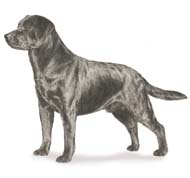
The Labrador Retriever (also Labrador, Labby, or Lab for short) is one of several kinds of retriever, a type of gun dog. The Labrador, once known as the Lesser Newfoundland, is the most popular breed of dog (by registered ownership) in the world, and is by a large margin the most popular breed by registration in the United States (since 1991), and the United Kingdom. It is also the most popular breed of assistance dog in the United States, Australia, and many other countries, as well as being widely used by police and other official bodies for their detection and working abilities. They are exceptionally affable, gentle, intelligent, energetic and good natured, and Labradors are generally considered good companions for people of all ages (including a high level of patience and tolerance for children), making them both excellent companions and working dogs. With training, the Labrador is one of the most dependable, obedient and multi-talented breeds in the world.
The ancestors of modern Labradors originated on the island of Newfoundland, now part of the province of Newfoundland and Labrador, Canada. The breed emerged over time from the St. John's Water Dog, also an ancestor of the Newfoundland dog (to which the Labrador is closely related), through ad-hoc breedings by early settlers in the mid to late 16th century. The original forebears of the St. John's dog have variously been suggested to be crossbreeds of the black St. Hubert's hound from France, working water dogs from Portugal, old European pointer breeds and dogs belonging to the indigenous peoples of the area. From the St. John's Dog, two breeds emerged; the larger was used for hauling, and evolved into the large and gentle Newfoundland dog, likely as a result of breeding with mastiffs brought to the island by the generations of Portuguese fishermen who had been fishing offshore since the 1400s. The smaller short-coat retrievers used for retrieval and pulling in nets from the water were the forebears of the Labrador Retriever. The white chest, feet, chin, and muzzle characteristic of the St. John's Dog often appears in Lab mixes, and will occasionally manifest in Labs as a small white spot on the chest or stray white hairs on the feet or muzzle.
The St. John's area of Newfoundland was settled mainly by the English and Irish. Local fishermen originally used the St. John's dog to assist in bringing nets to shore; the dog would grab the floating corks on the ends of the nets and pull them to shore. A number of these were brought back to the Poole area of England in the early 1800s, then the hub of the Newfoundland fishing trade, by the gentry, and became prized as sporting and waterfowl hunting dogs. A few kennels breeding these grew up in England; at the same time a combination of sheep protection policy (Newfoundland) and rabies quarantine (England) led to their gradual demise in their country of origin.
The first and second Earls of Malmesbury, who bred for duck shooting on his estate, and the 5th and 6th Dukes of Buccleuch, and youngest son Lord George William Montagu-Douglas-Scott, were instrumental in developing and establishing the modern Labrador breed in nineteenth century England. The dogs Avon ("Buccleuch Avon") and Ned given by Malmesbury to assist the Duke of Buccleuch's breeding program in the 1880s are usually considered the ancestors of all modern Labradors.
[ Return to top ]
Labradors are a well-balanced, friendly and versatile breed, adaptable to a wide range of functions as well as making very good pets. As a rule they are not excessively prone to being territorial, pining, insecure, aggressive, destructive, hypersensitive, or other difficult traits which sometimes manifest in a variety of breeds, and as the name suggests, they are excellent retrievers. As an extension of this, they instinctively enjoy holding objects and even hands or arms in their mouths, which they can do with great gentleness (a Labrador can carry an egg in its mouth without breaking it). They are also known to have a very soft feel to the mouth, as a result of being bred to retrieve game such as waterfowl. They are prone to chewing objects (though they can be trained out of this behaviour). The Labrador Retriever's coat repels water to some extent, thus facilitating the extensive use of the dog in waterfowl hunting.
[ Return to top ]